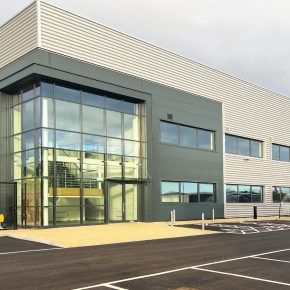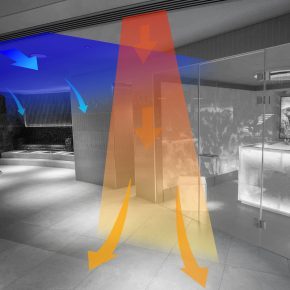
Clearing up confusion around the Criterion 3 check on summer heat gain
Marcus Eves, Sustainability Consultant at Darren Evans Assessments, discusses the importance of the Criterion 3 check on how much buildings are being heated via windows.
Summer overheating has been a hot topic in recent months, however the Building Regulations do make provision for limiting the effects of solar gain. Unfortunately despite being a requirement for compliance with Part L2A of the Building Regulations, the importance of the Criterion 3 check on how much buildings are being heated via windows is often overlooked and misunderstood.
 Whilst we are all familiar with the requirements of Criterion 1 (Compliance with the Building Emission Rate), Criterion 3 (Limiting the Effects of Solar Gains in Summer) always seems to get forgotten about. And when it comes to finding a route to achieving compliance it can leave some confused and frustrated.
Whilst we are all familiar with the requirements of Criterion 1 (Compliance with the Building Emission Rate), Criterion 3 (Limiting the Effects of Solar Gains in Summer) always seems to get forgotten about. And when it comes to finding a route to achieving compliance it can leave some confused and frustrated.
In commercial buildings compliance with the emissions targets is straightforward, proceeding through the reliable time-honoured menu; lower the U-values, improve the building services, enhance the controls and finally consider renewables. However many are unfamiliar with how the Criterion 3 check is performed in SBEM (the BRE’s Simplified Building Energy Model for non-domestic buildings). When it comes to compliance the implications of this can be drastic.
For the purposes of Part L, a ‘limiting solar gain check’ is performed for Criterion 3 compliance where the aggregated solar gains between April and September must be below a certain benchmark. It is crucial to understand that this does not mean a straightforward overheating check is carried out and is related to solar gain via windows only. Provisions must be taken to limit internal temperature rise due to solar gain in summer; this will reduce or eliminate the need for air conditioning or mechanical ventilation which will increase the building’s energy demand.
In Part L 2006 the Criterion 3 check carried out in the SBEM was based on overheating assessment and therefore any zones which were mechanically cooled were exempt. This gave a quick fix to developers: if a zone failed Criterion 3, a cooling system was added and a pass could be demonstrated. This is not the case anymore. Mechanical plant cannot simply be introduced to offset an issue as a result of poor façade design.
Consideration needs to be given to the design of the building very early on to limit solar gains entering the spaces. There are three main factors to consider:
- window size and orientation;
- solar protection through internal or external shading or improved glass specification;
- high thermal capacity.
When the Criterion 3 limit is exceeded by a small amount – up to 30% – consider the glazing specification and blinds. Windows with lower G-values will restrict the amount of solar radiation entering the space. Blinds will also have the same effect, but these are not appropriate for all spaces.
When the Criterion 3 limit is exceeded by a larger amount (up to 50%) consideration must be given to the glazed area proposed. A reduction in the number of openings or their size may be required. If curtain walling is proposed, spandrel panels can be introduced to reduce the area of glass but keep the overall feel of the building.
Finally external shading must be considered; such as the introduction of overhangs to windows, vertical or horizontal fins, or brise soleil. This will have significant impact on the building form and so will require resubmissions to planning, therefore it’s vital the impact of Criterion 3 compliance is identified at the earliest stage.
It must be noted that if external shading is required, SBEM does not take this fully into account. A full overheating study using a bespoke Dynamic Simulation Model will be required in order to demonstrate to building control that the internal comfort conditions will be met.
In summary, recognising that compliance Criterion 3 is restricted to solar gain from windows, it is important to also acknowledge there is a trade-off between maximising the benefit of daylight and limiting solar gains. Also it is essential to recognise the impact of Criterion 3 compliance prior to planning submission and that the introduction of building services such as air conditioning or mechanical ventilation are not a fix. Lastly, achieving compliance can be expensive and in some instances affect a building’s form.
Latest news

2nd April 2025
FIT Show 2025 Launches Innovative Marketplace Feature to Enhancing Value for Installers
FIT Show, the UK’s leading event for the window, door, flat glass, hardware, and roofing industries, is excited to announce the launch of a brand new Marketplace feature at its upcoming 2025 event (Birmingham NEC, 29 April – 1 May).
Posted in Architectural Ironmongery, Articles, Building Industry Events, Building Industry News, Building Products & Structures, Doors, Exhibitions and Conferences, Glass, Glazing, Hand Tools, Innovations & New Products, Plant, Equipment and Hire, Power Tools, Restoration & Refurbishment, Retrofit & Renovation, Roofs, Seminars, Training, Windows
2nd April 2025
Hi-spec deployment of EJOT Colorfast at new Birmingham logistics park
EJOT Colorfast fasteners have been used extensively in the construction of eight new high-specification warehousing and logistics buildings at the Urban 8 Logistics Park in King’s Norton, Birmingham.
Posted in Articles, Building Industry News, Building Products & Structures, Building Systems, Case Studies, Facades, Restoration & Refurbishment, Retrofit & Renovation, Roofs, Walls
2nd April 2025
SWA member delivers ‘fresh Hope’ for university’s Sustainable Building department
A detailed contract to restore an iconic Art Deco building in the heart of Birmingham’s Jewellery Quarter was carried out by Steel Window Association member, The Window Repair Company (Northwest) Limited.
Posted in Articles, Building Associations & Institutes, Building Industry News, Building Products & Structures, Building Systems, Case Studies, Glass, Glazing, Restoration & Refurbishment, Retrofit & Renovation, Steel and Structural Frames, Sustainability & Energy Efficiency, Windows
1st April 2025
Gilberts Takes Thermal Comfort to New Heights
Gilberts Blackpool is continuing to build on its reputation as a pioneer with the unveiling of ThermaAstute™ – the most extensive range of thermally sensitive diffusers in the market.
Posted in Air Conditioning, Articles, Building Industry News, Building Products & Structures, Building Services, Facility Management & Building Services, Heating, Ventilation and Air Conditioning - HVAC, Innovations & New Products, Restoration & Refurbishment, Retrofit & Renovation, Sustainability & Energy Efficiency
 Sign up:
Sign up: